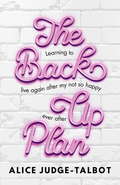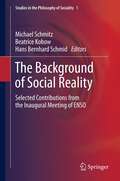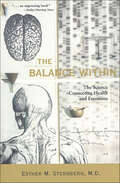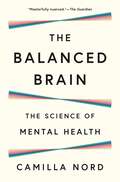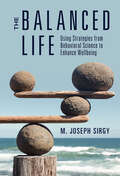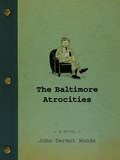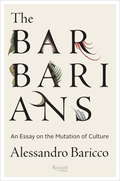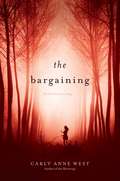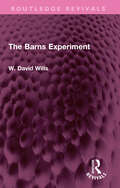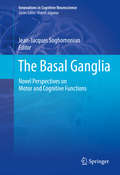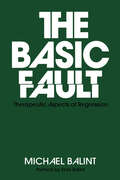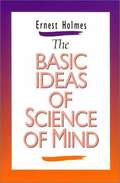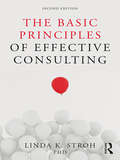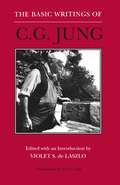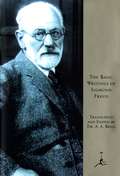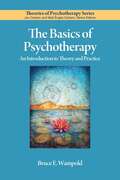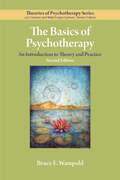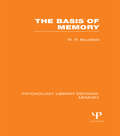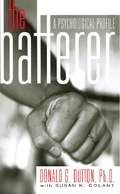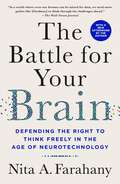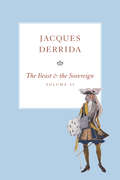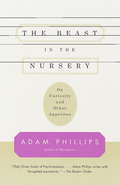- Table View
- List View
The Back-Up Plan
by Alice Judge-TalbotAt 27 years old, I found myself with a broken down marriage and two children under two to raise on my own. I had no other option than to survive. Nah, scratch that, I needed to thrive. But where would I begin? I wasn't sure if I knew how to live alone, let alone how to boss it solo with a couple of kids in tow. It's been a hell of a journey signposted with dating fails, money worries and ex-husband woes, but when was a Back-up Plan ever straightforward? This book is the one I needed to read in the lonely 3am darkness of an unfixable marriage, lying next to a man I was sure I didn't want to be tied to anymore but whom I was too scared to leave. This book is the one I needed to read when I picked up my first packet of anti-depressants and read Elizabeth Wurtzel's Prozac Nation to feel off-the-cuff and cool (but just felt more depressed). This book is the one I needed to read in the infinitely long days that stretched ahead of me alone with two infants, minimal sleep and no hope. This book is the one I needed to read when shamefully I carted my two toddlers to Boots to pick up my very first Morning After Pill after my very first One Night Stand. This book is the I needed to read when my world was about to fall apart.
The Back-Up Plan
by Alice Judge-TalbotAt 27 years old, I found myself with a broken down marriage and two children under two to raise on my own. I had no other option than to survive. Nah, scratch that, I needed to thrive. But where would I begin? I wasn't sure if I knew how to live alone, let alone how to boss it solo with a couple of kids in tow. It's been a hell of a journey signposted with dating fails, money worries and ex-husband woes, but when was a Back-up Plan ever straightforward? This book is the one I needed to read in the lonely 3am darkness of an unfixable marriage, lying next to a man I was sure I didn't want to be tied to anymore but whom I was too scared to leave. This book is the one I needed to read when I picked up my first packet of anti-depressants and read Elizabeth Wurtzel's Prozac Nation to feel off-the-cuff and cool (but just felt more depressed). This book is the one I needed to read in the infinitely long days that stretched ahead of me alone with two infants, minimal sleep and no hope. This book is the one I needed to read when shamefully I carted my two toddlers to Boots to pick up my very first Morning After Pill after my very first One Night Stand. This book is the I needed to read when my world was about to fall apart.
The Background of Social Reality: Selected Contributions from the Inaugural Meeting of ENSO
by Michael Schmitz Hans Bernhard Schmid Beatrice KobowThis volume aims at giving the reader an overview over the most recent theoretical and methodological findings in a new and rapidly evolving area of current theory of society: social ontology. This book brings together philosophical, sociological and psychological approaches and advances the theory towards a solution of contemporary problems of society, such as the integration of cultures, the nature of constitutive rules, and the actions of institutional actors. It focuses on the question of the background of action in society and illuminates one of the most controversial, cross-disciplinary questions of the field while providing insight into the ontological structure of groups as agents. This volume offers an interesting and important contribution to the debate as it does well in bridging the gap between the analytical and the continental tradition in social philosophy. In addition, this volume expands the reach and depth of the philosophy of sociality by relating it to philosophical ideas from the late 19th and early 20th centuries and to key thinkers such as Husserl, Heidegger, and Bourdieu. The contributors include internationally renowned scholars as well as a highly selected set of younger scholars whose work is at the cutting edge of their field. Scholarly, yet accessible, this book is an essential resource for researchers across the social sciences.
The Balance Within: The Science Connecting Health and Emotions
by Esther M. Sternberg“A dazzling tour of a most promising area of neuroscience—the interface between the immune system and the nervous system.” —Elliot S. Gershon, MD, Professor of Psychiatry, The University of ChicagoSince ancient times humans have felt intuitively that emotions and health are linked, and recently there has been much popular speculation about this notion. But until now, without compelling evidence, it has been impossible to say for sure that such a connection really exists and especially how it works.Now, that evidence has been discovered.In this beautifully written book, Dr. Esther Sternberg, whose discoveries were pivotal in helping to solve this mystery, provides firsthand accounts of the breakthrough experiments that revealed the physical mechanisms—the nerves, cells, and hormones—used by the brain and immune system to communicate with each other. She describes just how stress can make us more susceptible to all types of illnesses, and how the immune system can alter our moods. Finally, she explains how our understanding of these connections in scientific terms is helping to answer such crucial questions as “Does stress make you sick?” “Is a positive outlook the key to better health?” and “How do our personal relationships, work, and other aspects of our lives affect our health?”A fascinating, elegantly written portrait of this rapidly emerging field with enormous potential for finding new ways to treat disease and cope with stress, The Balance Within is essential reading for anyone interested in making their body and mind whole again.“Dr. Sternberg weaves historical perspective, recent lab results, academic rigor and popular appeal into an engrossing book.” —The Dallas Morning News
The Balanced Brain: The Science of Mental Health
by Camilla NordHow we can use what we&’ve learned about the brain to improve our mental healthThere are many routes to mental well-being. In this groundbreaking book, neuroscientist Camilla Nord offers a fascinating tour of the scientific developments that are revolutionising the way we think about mental health, showing why and how events—and treatments—can affect people in such different ways.In The Balanced Brain, Nord explains how our brain constructs our sense of mental health—actively striving to maintain balance in response to our changing circumstances. While a mentally healthy brain deals well with life&’s turbulence, poor mental health results when the brain struggles with disruption. But just what is the brain trying to balance? Nord describes the foundations of mental health in the brain—from the neurobiology of pleasure, pain and desire to the role of mood-mediating chemicals like dopamine, serotonin and opioids. She then pivots to interventions, revealing how antidepressants, placebos and even recreational drugs work; how psychotherapy changes brain chemistry; and how the brain and body interact to make us feel physically (as well as mentally) healthy. Along the way, Nord explains how the seemingly small things we use to lift our moods—a piece of chocolate, a walk, a chat with a friend—work on the same pathways in our brains as the latest treatments for mental health disorders.Understanding the cause of poor mental health is one of the crucial questions of our time. But the answer is unique to each of us, and it requires finding what helps our brains rebalance and thrive. With so many factors at play, there are more possibilities for recovery and resilience than we might think.
The Balanced Life: Using Strategies from Behavioral Science to Enhance Wellbeing
by M. Joseph SirgyThe balanced life is a state of equally moderate-to-high levels of satisfaction in important and multiple life domains that contribute to overall life satisfaction. This book strives to improve the reader's understanding of what the balanced life is, and how it can be both achieved and maintained. Its primary goal is therefore to identify the major principles of life balance, and to introduce a comprehensive construct of the balanced life reflective of these principles. It discusses how life balance substantially contributes to subjective well-being – defined as life satisfaction, a preponderance of positive over negative feelings, and absence of ill-being – and explores strategies to attain life balance. It argues that achieving life balance, through manipulating one's thoughts and taking concrete action, will lead to increased personal happiness. Aimed at professional, academic, and lay audiences, this book is grounded in scientific studies related to work-life balance and the balanced life.
The Baltimore Atrocities: A Novel
by John Dermot WoodsPraise for John Dermot Woods:"Poignant and unsettling, and much like a good short story collection these tales resonate long after the book is closed."-Largehearted Boy"An accomplished artist and writer, in addition to being an entertaining and often an electrifying one. John Woods does something very original in his combining of the arts in this collection, and my hat's off to him in his two-hat achievement."-Stephen Dixon"Like a lost season of The Wire directed by Richard Linklater, The Baltimore Atrocities beguiles, bemuses, often horrifies, and never fails to impress. John Woods renders small moments of intimacy and violence with remarkable compression and eerie calm; together they form a rich disturbing portrait of the city-as-zonked-out-slaughterhouse, its denizens both the butchers and the butchered."-Justin Taylor, author of FlingsThe Baltimore Atrocities is a mordant, deadpan collection of more than one hundred murders, betrayals, heartbreaks, suicides, and bureaucratic snafus-each with a half-page illustration by the author-that tells the story of a couple who spends a year in Baltimore in search of their respective siblings, who were abducted decades earlier as young children.John Dermot Woods is a writer and cartoonist living in Brooklyn, New York. He is the author of a collection of comics, Activities (Publishing Genius, 2013), and two previous illustrated novels, No One Told Me I Was Going to Disappear (with J.A. Tyler) and The Complete Collection of people, places & things. He and Lincoln Michel created the funny comic strip Animals in Midlife Crises for the Rumpus. He is a professor of English at Nassau Community College.
The Barbarians
by Alessandro Baricco Stephen SartarelliFrom one of Italy's most respected literary voices, a manifesto on the state of global culture and how connectivity is changing the way we experience it. For the gatekeepers of traditional high culture, the rise of young ambitious outsiders has indeed seemed like nothing short of a barbarian invasion. In this concise and powerful manifesto, Alessandro Baricco explores a handful of realms that have been "plundered"-wine, soccer, music, and books-and extrapolates that it is not a case of old values against new but a widespread mutation that we are all part of, leading toward a different way of having experiences and creating meaning.
The Bargaining
by Carly Anne WestThe Shining meets The Conjuring in this chilling and suspenseful new novel from the author of The Murmurings.The fact that neither of her parents wants to deal with her is nothing new to Penny. She's used to being discussed like a problem, a problem her mother has finally passed on to her father. What she hasn't gotten used to is her stepmother...especially when she finds out what she'll have to spend the summer with April in the remote woods of Washington to restore a broken-down old house. Set deep in a dense forest, the old Carver House is filled with abandoned antique furniture, rich architectural details, and its own chilling past. The only respite Penny can find away from April's renovations is in Miller, the young guy who runs the local general store. He's her only chance at a normal, and enjoyable, summer. But Miller has his own connection to the Carver house, and it's one that goes beyond the mysterious tapping Penny hears at her window, the handprints she finds smudging the glass panes, and the visions of children who beckon Penny to follow them into the dark woods. Miller's past just might threaten to become the terror of Penny's future...
The Barns Experiment (Routledge Revivals)
by W. David WillsOriginally published in 1945, this is a concise account of the remarkable experiment with boys carried out by the author of The Hawkspur Experiment. The war put this latter experiment into abeyance, but gave its author an opportunity to practice his principles on a group of younger difficult boys. Aged from eight to fourteen, these boys were the "throw-outs" of the Evacuation Scheme, but before the Barns experiment had been long in operation troublesome boys were being evacuated not primarily to escape bombs, but in order that they might have the treatment that Barns provided. Barns was a Hostel-school initiated by the Society of Friends, where lawless boys made their own laws, and where the principle instrument in their reformation was not punishment but affection. So successful were the unconventional methods here described that sceptics were convinced, and Barns has now achieved a permanent place in the field of "the therapy of the dis-social." Today it would be described as a therapeutic community and is one of the earliest experiments of its kind that raised awareness and paved the way for further research in this area.
The Basal Ganglia
by Jean-Jacques SoghomonianThis groundbreaking text takes current knowledge of the basal ganglia far from well-known motor-based models to a more inclusive understanding of deep-brain structure and function. Synthesizing diverse perspectives from across the brain-behavioral sciences, it tours the neuroanatomy and circuitry of the basal ganglia, linking their organization to their controlling functions in core cognitive, behavioral, and motor areas, both normative and disordered. Interactions between the basal ganglia and major structures of the brain are identified in their contributions to a diverse range of processes, from language processing to decision-making, emotion to visual perception, motivation to intent. And the basal ganglia are intimately involved in the mechanisms of dysfunction, as evinced by chapters on dyskinesia, Parkinson's disease, neuropsychiatric conditions, and addictions. Included in the coverage: Limbic-basal ganglia circuits: parallel and integrative aspects. Dopamine and its actions in the basal ganglia system. Cerebellar-basal ganglia interactions. The basal ganglia contribution to controlled and automatic processing. The basal ganglia and decision making in neuropsychiatric disorders. The circuitry underlying the reinstatement of cocaine seeking: modulation by deep brain stimulation. The basal ganglia and hierarchical control in voluntary behavior. Its breadth and depth of scholarship and data should make The Basal Ganglia a work of great interest to cognitive psychologists and neuroscientists, neuropsychologists, neurologists, neuropsychiatrists, and speech-language pathologists.
The Basic Fault: Therapeutic Aspects of Regression
by Michael BalintIn this volume, Michael Balint, who over the years made a sustained and brilliant contribution to the theory and technique of psychoanalysis, develops the concept of the 'basic fault' in the bio-psychology structure of every individual, involving in varying degree both mind and body. Balint traces the origins of the basic fault to the early formative period, during which serious discrepancies arise between the needs of the individual and the care and nurture available. These Discrepancies create a kind of deficiency state.On the basis of this concept, Balint assumes the existence of a specific area of the mind in shich all the processes have an exclusively two-person structure consisting of the individual and the individual's primary object. Its dynamic force, originating from the basic fault has the overwhelming aim of 'putting things right'. This area is contrasted with two others: the area of the Oedipus complex, which has essentially a triangular structure comprising the individual and two of his objects, and whose characteristic dynamism has the form of a conflict; and the area of creation, in which there are no objects in the proper sense, and whose characteristic force is the urge to create, to produce
The Basic Ideas of Science of Mind
by Ernest HolmesA brief, straightforward and user-friendly account of the Science of Mind philosophy and teach, written in the last years of his life by the man who developed it.
The Basic Principles of Effective Consulting
by Linda K. StrohConsultants are called upon more and more to help implement needed organizational changes, fill gaps in workforce capabilities, and solve significant business problems. As the demand for consultants increases, it is critical that practitioners differentiate themselves and understand how they can be most successful, for themselves and their clients. The Basic Principles of Effective Consulting details what effective consultants do and provides a step by step process of just how they do it. The Second Edition of The Basic Principles of Effective Consulting is fully updated with real-life cases. End-of-chapter summaries foster both mastery and engagement, as well as providing a quick reference throughout a consultant’s career. In addition, each chapter includes a section "From the experts" written by successful consultants and users of consultants’ services. These experts share ideas and tips about their own consulting experiences that relate to chapter material. The book is written for entry level and seasoned consultants, project managers, staff advisors, and anyone who wants to learn (or be reminded of) the basic principles of effective consulting. The book is well suited as an excellent textbook for college courses on consulting, organizational training, and a lifetime go-to consultant’s resource.
The Basic Writings of C. G. Jung
by C. G. Jung Violet Staub De LaszloIn exploring the manifestations of human spiritual experience both in the imaginative activities of the individual and in the formation of mythologies and of religious symbolism in various cultures, C. G. Jung laid the groundwork for a psychology of the spirit. The excerpts here illuminate the concept of the unconscious, the central pillar of his work, and display ample evidence of the spontaneous spiritual and religious activities of the human mind. This compact volume will serve as an ideal introduction to Jung's basic concepts.
The Basic Writings of C.G. Jung: Revised Edition (Bollingen Series #666)
by C. G. JungIn exploring the manifestations of human spiritual experience both in the imaginative activities of the individual and in the formation of mythologies and of religious symbolism in various cultures, C. G. Jung laid the groundwork for a psychology of the spirit. The excerpts here illuminate the concept of the unconscious, the central pillar of his work, and display ample evidence of the spontaneous spiritual and religious activities of the human mind. This compact volume will serve as an ideal introduction to Jung's basic concepts. Part I of this book, "On the Nature and Functioning of the Psyche," contains material from four works: "Symbols of Transformation," "On the Nature of the Psyche," "The Relations between the Ego and the Unconscious," and "Psychological Types." Also included in Part I are "Archetypes of the Collective Unconscious" and "Psychological Aspects of the Mother Archetype." Part II, "On Pathology and Therapy," includes "On the Nature of Dreams," "On the Pathogenesis of Schizophrenia," and selections from "Psychology of the Transference." In Part III appear "Introduction to the Religious and Psychological Problems of Alchemy" and two sections of "Psychology and Religion." Part IV, called "On Human Development," consists of the essay "Marriage as a Psychological Relationship."
The Basic Writings of Sigmund Freud
by Sigmund FreudThis classic edition of The Basic Writings of Sigmund Freud includes complete texts of six works that have profoundly influenced our understanding of human behavior, presented here in the translation by Dr. A. A. Brill, who for almost forty years was the standard-bearer of Freudian theories in America.• Psychopathology of Everyday Life is perhaps the most accessible of Freud’s books. An intriguing introduction to psychoanalysis, it shows how subconscious motives underlie even the most ordinary mistakes we make in talking, writing, and remembering. • The Interpretation of Dreams records Freud’s revolutionary inquiry into the meaning of dreams and the power of the unconscious. • Three Contributions to the Theory of Sex is the seminal work in which Freud traces the development of sexual instinct in humans from infancy to maturity.• Wit and Its Relation to the Unconscious expands on the theories Freud set forth in The Interpretation of Dreams. It demonstrates how all forms of humor attest to the fundamental orderliness of the human mind.• Totem and Taboo extends Freud’s analysis of the individual psyche to society and culture.• The History of Psychoanalytic Movement makes clear the ultimate incompatibility of Freud’s ideas with those of his onetime followers Adler and Jung.
The Basics of Psychotherapy: An Introduction to Theory and Practice (Theories of Psychotherapy Series)
by Bruce E. WampoldIn The Basics of Psychotherapy: An Introduction to Theory and Practice, author Bruce E. Wampold presents essential background necessary for understanding the role of theory in therapy, and shows how understanding psychotherapy theory is the first step to becoming an effective therapist.
The Basics of Psychotherapy: An Introduction to Theory and Practice (Theories of Psychotherapy Series®)
by Dr. Bruce E. Wampold PhDThis book presents essential background necessary for understanding the role of theory in psychotherapy practice, and shows how understanding psychotherapy theory is the first step to becoming an effective therapist. The author provides a thorough but concise overview of the history of psychotherapy, the evolution of psychotherapy theories, and research on the effectiveness of various psychotherapies in general practice and for treatment of specific common disorders.The Basics of Psychotherapy, now in its second edition, is an accessible, handy resource for students training to be psychotherapists and practitioners seeking to reevaluate theories and corresponding therapies. As the foundational book in the Theories of Psychotherapy Series, this title may be read first or in combination with other books in the series to establish a thorough understanding of psychotherapy and its variants. This updated second edition incorporates new developments in theory and research, new approaches including advances in culturally sensitive therapy, and updates in the classification of mental illness.
The Basics: A Curriculum for Co-Occurring Psychiatric and Substance Disorders Volume I & II (Second Edition)
by Rhonda MckillipIs integrated treatment a priority? A requirement? Do you attend lots of training? Buy lots of books? Yet find it a challenge to know exactly what to say to a psychiatric consumer with an addictive disorder or an addiction client with a psychiatric disorder? THE BASICS, SECOND EDITION is the complete solution with detailed lesson content and handouts for groups, topics and information for individual sessions, and comprehensive cross training education for mental health and chemical dependency professionals. Integrating your treatment program, providing dual diagnoses educational material, and cross-training your staff doesn't get any easier than this! THE BASICS eliminates gaps. When a publication focuses first on training the professional, the professional must transfer the knowledge into a useful format and into conversational language. THE BASICS is the treatment by first providing ready to present material. A professional is then simultaneously cross-trained on psychiatric and substance disorders by learning literally how to provide treatment to the dually diagnosed population. With over 1,600 references, THE BASICS is a Consensus-Based Best Practice. It is specifically designed to match the evidence based best practices consistent with the CCISC Model (Minkoff & Cline), Stages of Change Model (Prochaska & DiClemente), and Motivational Interviewing (Miller & Rollnick). Treatment participants benefit by consistent psychoeducation in groups, in 1:1's, and throughout a system of care. Group participants benefit by practicing skills with the use of reproducible Worksheets. Professionals benefit by a detailed curriculum written in a "conversational style." Administration and staff benefit by drastically reducing hours devoted to program development. Direct service providers benefit by a continuity of material for group and 1x1's.
The Basis of Memory (Psychology Library Editions: Memory)
by W.R. BousfieldOriginally published in 1928 this short essay looks two rival theories of the time, both hypothetical, and explores which one ‘better fits the facts’. Whether memory depends on "enduring traces" in brain structure (to use the language of Professor Semon), or whether it depends on records in "psychical structure" (to use the language of Professor McDougall). Today it can be read and enjoyed in its historical context.
The Batterer: A Psychological Profile
by Susan K. Golant Donald G. DuttonWhat kind of man deliberately hurts the woman he loves? Drawing on his pathbreaking studies of more than seven hundred abusive men, as well as therapy with hundreds more, Dutton paints a dramatic and surprising portrait of the man who assaults his intimate partner.
The Battle for Your Brain: Defending the Right to Think Freely in the Age of Neurotechnology
by Nita A. FarahanyA new dawn of brain tracking and hacking is coming. Will you be prepared for what comes next?Imagine a world where your brain can be interrogated to learn your political beliefs, your thoughts can be used as evidence of a crime, and your own feelings can be held against you. A world where people who suffer from epilepsy receive alerts moments before a seizure, and the average person can peer into their own mind to eliminate painful memories or cure addictions.Neuroscience has already made all of this possible today, and neurotechnology will soon become the “universal controller” for all of our interactions with technology. This can benefit humanity immensely, but without safeguards, it can seriously threaten our fundamental human rights to privacy, freedom of thought, and self-determination.From one of the world’s foremost experts on the ethics of neuroscience, The Battle for Your Brain offers a path forward to navigate the complex legal and ethical dilemmas that will fundamentally impact our freedom to understand, shape, and define ourselves.
The Beast and the Sovereign, Volume II
by Jacques DerridaFollowing on from The Beast and the Sovereign, Volume I, this book extends Jacques Derrida's exploration of the connections between animality and sovereignty. In this second year of the seminar, originally presented in 2002-2003 as the last course he would give before his death, Derrida focuses on two markedly different texts: Heidegger's 1929-1930 course The Fundamental Concepts of Metaphysics, and Daniel Defoe's Robinson Crusoe. As he moves back and forth between the two works, Derrida pursuesthe relations between solitude, insularity, world, violence, boredom and death as they supposedly affect humans and animals in different ways. Hitherto unnoticed or underappreciated aspects of Robinson Crusoe are brought out in strikingly original readings of questions such as Crusoe's belief in ghosts, his learning to pray, his parrot Poll, and his reinvention of the wheel. Crusoe's terror of being buried alive or swallowed alive by beasts or cannibals gives rise to a rich and provocative reflection on death, burial, and cremation, in part provoked by a meditation on the death of Derrida's friend Maurice Blanchot. Throughout, these readings are juxtaposed with interpretations of Heidegger's concepts of world and finitude to produce a distinctively Derridean account that will continue to surprise his readers.
The Beast in the Nursery
by Adam PhillipsIf you are disturbed by the idea that to grow up is to learn to live with disillusionment, if you are fascinated by the perplexity of child-rearing, or if you fear you were more creative as a child, The Beast in the Nursery offers an illuminating and possibly life-changing experience. In four interrelated essays, Adam Phillips arrives at startling new insights into issues that preoccupied Freud, showing in the process that far from having lost its relevance, psychoanalysis is still one of our most incisive tools for the exploration of the human psyche and its possibilities. Phillips transforms the genre of the essay into an instrument for intellectual investigation of the most absorbing kind.From the Trade Paperback edition.
